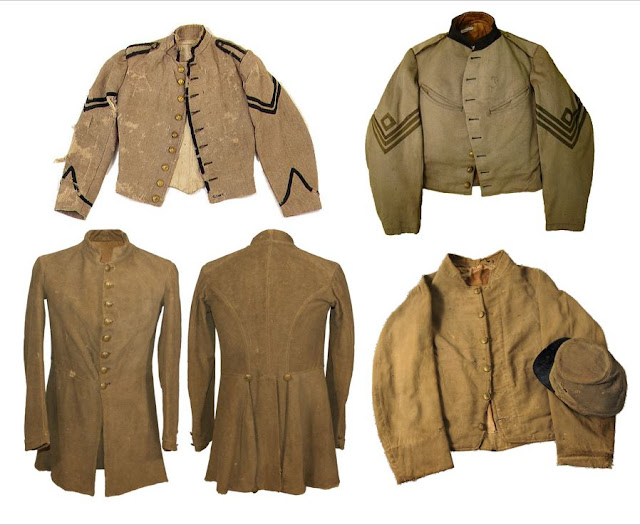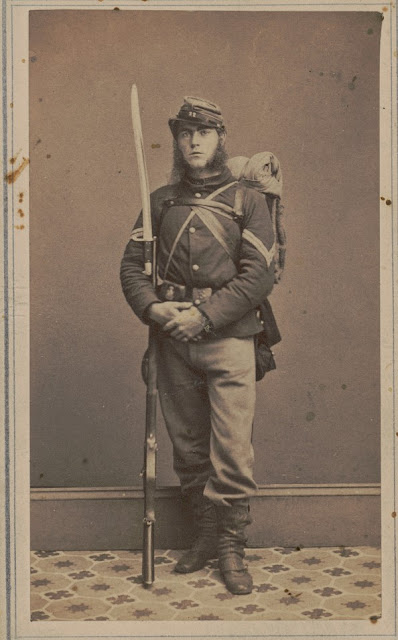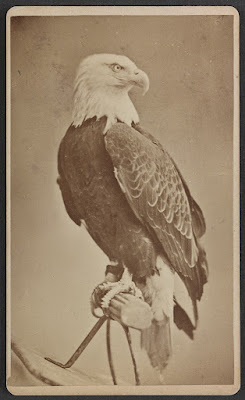Atop Snodgrass Hill: The Second Day at Chickamauga with the 89th Ohio
Through a historical coincidence, I had two members of
my family among the defenders of Snodgrass Hill during the battle of
Chickamauga. Private Joseph H. Carter who was serving in Co. H of the 89th
Ohio Volunteer Infantry is my great-great-great grandfather on my father’s side
while Private Frederick McLargin of Co. C of the 21st Ohio Volunteer
Infantry is my great-great-great-great uncle on my mother’s side. Both of them survived
the battle and escaped being captured, although Uncle Fred was wounded during
the fighting on September 20, 1863.
Much has been written about the services of
the 21st Ohio on Snodgrass Hill, and rightfully so, but today’s blog
post will feature an account from another of those gallant defenders of the
Hill, the 89th Ohio. Captain David M. Barrett was commanding
officer of Co. I and was captured along with most of the regiment during the
evening of September 20, 1863 atop Snodgrass Hill. He wrote the
following account to his wife while at imprisoned at Libby Prison in Richmond,
Virginia which was published in the December 24, 1863 issue of the Highland Weekly News of Hillsboro, Ohio.
Libby Prison, Richmond, Virginia
November 15, 1863
I
recovered from my camp sickness and when I joined the regiment at Bridgeport,
Alabama, the doctor and colonel both said I had better stay back. I told the
colonel I was going with him if he would let me. He said he expected we would
have pretty hard times. I improved and felt well for several days but was sick
again on the 15th. When the regiment went out to Ringgold about 14
miles on a reconnaissance with General [James B.] Steedman, who was in command
of six regiments, I rode in the ambulance until we nearly arrived at the rebel
pickets and then took command of my company and remained with it during the
engagement which was only a skirmish and returned to the ambulance. I was
always determined my company should not go into a fight without me if I was
possibly able to be with them. We returned to camp all safe and right the next
day.
We were ordered out early on Saturday morning the 19th and all knew it was a fight then. We knew Rosecrans had telegraphed to Chattanooga the night before that the fight would commence that day. We went out with 339 men and were engaged about two hours that evening in a skirmish and partial engagement, making it, what we thought, tolerably hot about half the time. I had only one man wounded in my company that evening.
We lay on our arms in line of battle
during the night until about 8 o’clock in the morning when we fell back about a
mile and reformed our line in an advantageous position and lay down to receive
the attack of the momentarily expected enemy. In a very short time our wagon
came up and issued two days’ rations of coffee, sugar, bread, and meat. The boys were very hungry and began to put them in haversacks as fast as possible
but before we could possibly get them all in we were ordered to fall in and
march to the rear a short distance and then crossed at once to the right of
General Thomas’ corps, a distance of nearly five miles. With the brave General
Gordon Granger and General Steedman at our head, we were at once ordered
forward to gain a certain elevated point on Missionary Ridge and hold it at all
hazards. This we did, going forward on double quick time. A good part of the
time we could not see the men for the dust. For the last mile we were shelled
on both sides by the Rebels but went on the double-quick step, dodging
occasionally as the shells came closer, until we gained the point to which we
were ordered; the 22nd Michigan was in front of us and the 115th
Illinois in front of them.
Very soon, however after our line halted,
the 22nd Michigan fell back under a heavy fire to our left and
formed on it. Another moment and here came the 115th Illinois,
wounded, straggling, running, and line broken. At this moment, our men began to
prick up their ears as they heard the yells of the Rebels as they followed closely
after the Michigan and Illinois troops, pouring into their broken ranks a very
heavy fire. General Steedman rode along the line in front of them and tried in
vain to rally them as they approached our line. Colonel [Caleb] Carlton ordered
our regiment to lie down, which we did, and they [115th Illinois] passed
over us, trampling a good many of our men as they went over the line, some with
and some without guns, some carrying wounded, others limping on one leg and so
on.
It was at this moment our regiment was to
be tried, the Rebel lines following up with a yell, as if their victory was
complete. As the balls began to reach our line, I shall never forget the
command of our gallant little colonel, who knew we were not accustomed to such
a fire as was coming. He sat on his horse within a few rods of where General
Steedman’s horse had been shot under him, and where a few minutes after, his
own horse suffered the same fate, but he sat as cool as a preacher in a pulpit
and commanded, “Steady, steady, steady!” Then we opened a terrific fire of
volley after volley into their ranks for the space of three-quarters of an
hour, their line waving to and fro, while ours was a steady as a clock, and by
this time they went back, leaving the ground literally strewn with their dead
and wounded.
 |
| 89th Ohio Volunteer Infantry national colors (Ohio History Connection) |
We had no orders to go forward and did not follow them but had not long to wait till they come again with fresh troops to dislodge us from our position, but we again sent them back howling as before and so on until nearly dark. They made charge after charge against our single line only to be as often repulsed with great slaughter each time to them and comparatively small loss on our side.
It was now nearly night when the lines having given way on both right and left of us, we were subjected to an enfilading fire of shot, shell, and musketry thus flanking us so that we were forced to turn our line, but we rallied again and charged again, driving them back. By this time our ammunition was gone, having fired 60 rounds, besides all we could gather from the dead and wounded. The firing having ceased, we selected a spot to lie down and await the darkness of night to work our way back, knowing the Rebels were three or four lines deep in our rear. We had sent back an hour before sundown that our ammunition was nearly gone, but the order came back as before, to hold the point.
Soon after dark, the Rebels knowing we were there, so disposed their forces as to open fire and charge us from three sides, having a brigade on the fourth or front to renew the attack while the others closed in and surrounded us, and thus we were sacrificed to save the other part of the army and prevent a complete rout of our whole line and the Rebel occupation of Chattanooga. All the accounts of the great battle admit that for the timely aid of General Granger, Thomas would have been overwhelmed and ruined after the falling to pieces of Crittenden’s and McCook’s corps. It was when we were flanked and forced to turn our line that our regiment suffered severely. I had 29 men in the fight and two were killed and 18 taken prisoners. About three or four ran away during the fight- their names I forbear to mention.















Dan, I recently found out my great great great grandfather was in company H of the 89th ohio. I have official roster documents of company H and indeed saw your great great grandfathers name on that roster. I was wondering if you have any additional information on company H and/or the 89th Ohio and where I might be able to get that information .
ReplyDeleteDustin- that's outstanding! Glad to hear from another comrade of Co. H. Grandpa Joe Carter passed away in 1907 and is buried in Missouri. A couple of recommendations: please check out Bryan P. Weaver's Sacrifice at Chickamauga published back in 2003- you should be able to find a copy on the secondary book market. The other book worth checking out is a collection of letters from Jacob Shively of Co. D entitled 'Dear Companion...Yours Until Death." If you contact the Ross County Historical Society in Chillicothe, they may still have copies as they were the entity that published the book.
DeleteOne more place to check is Larry Stevens' outstanding Ohio in the Civil War website; here's the link for the 89th Ohio: http://www.ohiocivilwar.com/cw89.html
DeleteDan, Thank you so much for this information. I will have to check it out. I'm not sure if you've ever been to Missouri to visit his grave, but it appears he is about 90 minutes away from me and if you don't mind i'd like to visit and pay my respects by placing an American Flag at his grave. Also i plan to go to Chickamauga in the spring with a friend who happens to have a history channel on multiple social outlets and he may highlight the 89th Ohio's battle at Snodgrass Hill/ Horseshoe Ridge. My email is dwise0707@gmail.com and that would be the best way to reach me. I'd love to hear back on your thoughts about my visit to Joseph Carter's grave.
ReplyDeleteThat would be an honor- my grandmother visited the grave a number of years ago on one of her trips across the country- she had never met him or his son Craig who was her grandfather. I will send you an email with a photo of me standing next to the 89th Ohio monument on Snodgrass Hill from back in March. It was an incredible experience.
Delete